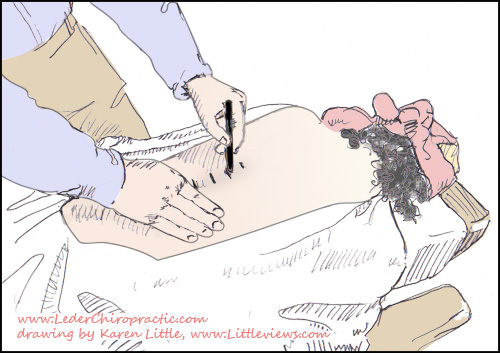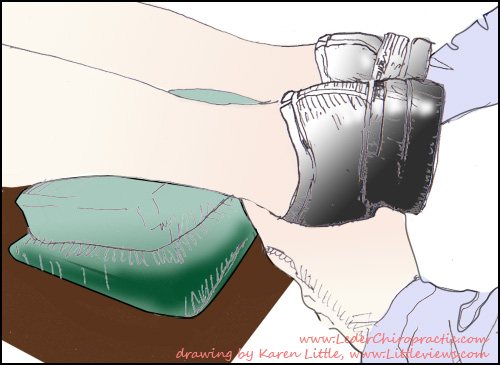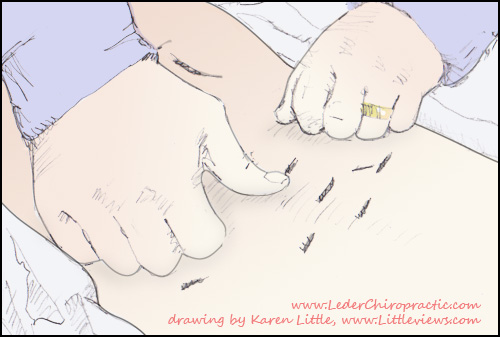Directional Non-Force Technique(R), also known as "DNFT" Chiropractic
Non-Force chiropractic techniques correct the majority of structural problems that cause pain commonly experienced in the low back, neck, and head, with most of these problems corrected in very few visits. (We'll post a study on the subject a bit later this month.)
What is our definition of a few visits? Two to six, and Dr. Leder would be surprised if it took more. But frankly, unless you asked Dr. Leder to help you heal after you've suffered serious injury, you are the judge of the effectiveness of your treatment. If Dr. Leder took too long, his treatment wasn't successful (or he charged you too much money), you'd be the first to go elsewhere. Your success is his success and his joy.
What to Expect

Briefly, Dr. Leder observes your body's reaction to light touch. If touching on one side of the spine produces a contraction in an extremity, like your leg or arm, a problem is identified. Gentle pressure on the opposite side of the spine eliminates the contraction.
After listening to your problem (or problems), Dr. Leder has you lay face down on an examination table, covered in a white gown with your back exposed. On your exposed back, he draws light (easily removable) lines on top of each spinal bone, as well as on some other areas. These marks allow him to accurately apply pressure to problem areas during treatment without having to hunt for the exact spot each time he begins a new procedure.
And Those Shoes?

After marking your back, Dr. Leder places a half-shoe with thick heel on each of your feet. The purpose of these half-shoes is to observe when the heels line up.
If you start your treatment with muscles contracted (which is the cause of subluxation, or spinal misalignment), those heels usually do not line up. In fact, when Dr. Leder touches a hot spot (tender spot) on your back, one of your legs will contract, causing the shortened leg to lift slightly.
Gentle Motions

With your back and corresponding hot spots marked, Dr. Leder systematically presses until all spasms are relieved.
While most patients experience instant relief of their most painful problems, it may take a few more visits before everything is OK. Why? Often, several problems are present at once. These include head, neck, arm, hand, leg, and foot problems, plus pain in the back itself. Sometimes, pain in one area is so intense that it masks pain in another. When the first pain is relieved, the second is noticed.
What Is Muscle Tension and Subluxation?
Muscle tension refers to a muscle contraction that does not release. Motion can be forced when muscles are contracted, but this tension pulls on your bones, especially on your spinal bones. When your spinal bones become misaligned because of tension, they clamp (pinch) your nerves, which is why you feel pain. Some pain can feel like arthritis, joint problems, or even broken bones. Experiencing relief after an adjustment is truly amazing!
To feel the effect of muscle tension right now so that you understand the concept, ball your hand into a tight fist and bring it to your ear. Now flex and hold your upper arm muscle tight (pretend you are showing off your muscle). Keeping your fist balled and your muscles tight, reach out forward, completely stretching your arm (but only if it doesn't hurt).
While you can always move stiff muscles, they restrict motion. If you tried the above experiment, you will feel the extra force being exerted on related body parts, such as in this case, your shoulder blade, lower neck, and even rib cage. After experiencing this type of compression day after day, but maybe in your shoulders or lower back, you tend to forget what normal motion feels like. Compounding the problem is that while in this state, your blood supply to tense muscles decreases, causing your muscles to atrophy and elasticity to diminish.
When your body is not well, muscle tension can occur anywhere on it! And tense muscles are not isolated. One pulls another. That pulls a third, and so on. When your muscles are tight, related bones that are designed to move flexibly are pulled out of alignment, weaking your entire body structure. Pain warns you not to press your luck by taking part in pressure-producing activities because when muscles fail to properly support your body, subluxation and pinched nerves ensue.
Correcting Your Problems with Non-Force Chiropractic Techniques
As discussed above, tension and pressure causes problems. Relief, then, requires gentle treatment. No twisting. No cracking. No after-treatment swelling.
All drawings on this site are the property of www.LederChiropractic.com. Drawings created by Karen Little, www.Littleviews.com
Questions?
Phone: 1 (347) 631-2855
Website: www.LederChiropractic.com
|






